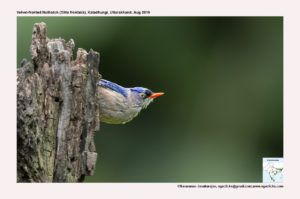
Velvet-fronted Nuthatch Sitta frontalis
Etymology:
- Sitta : Greek word for a bird like a woodpecker
- Frontalis : Latin word for fronted derived from frontis – forehead, front.
Vernacular Names: Hindi: Siri, Sans: Shilindhri, Cachar: Dao-mojo-buku-gajao, Guj: Makhmali zad-chad, Nil siri, Mar: Makhmali Shilindri/ siri, Ta: Pasai edukira kuruvi, Mal: Tandan kili, Sinh: Panu-kurulla
Distribution in India: Resident of Himalayas and hills of India.
Description:
Size of 12–13·5 cm; wt. of 8·5–17 g . It is a medium-small nuthatch with bright red bill (blackish in juvenile), yellow eye and eyering, black forehead and violet-blue upperparts. The male of nominate race in fresh plumage has lores; forecrown and narrow postocular stripe are black. The crown, upperparts and lesser and median upperwing-coverts are violet-blue, brighter and paler blue immediately adjacent to black forecrown. The greater upperwing-coverts are blue-grey with diffuse violet-blue fringes, alula and primary coverts blackish, smaller feathers of alula and distal parts of primary coverts fringed violet-blue, tertials grey-blue, longest tertial with concealed blackish stripe along shaft, secondaries and inner primaries greyish-black, grading to grey-blue sub marginally, with narrow brighter blue fringes. The central tail feathers are grey-blue with violet-blue fringes, other rectrices are black, tipped grey-blue and on outer web fringed violet-blue, outer three feather pairs with slightly paler subterminal spot on inner web. The cheek is dull violet-blue, fading to lavender on ear-coverts and side of neck. The chin and throat are whitish, breast is dull beige, flanks and belly to vent are darker and drabber , undertail-coverts are dull beige, diffusely tipped lavender; axillaries are whitish, anterior are feathers tipped dull violet-blue, underwing-coverts are black, longer under primary coverts and base of primaries are whitish. In worn plumage it is duller and greyer above, and underparts are slightly duller, pale grey-white with dull buff wash (less lilac). The iris is yellow, dull pale yellow to orange-red eyering; bill is red, tip of upper mandible is blackish; legs are dark brown, soles are orange-yellow. The female is like male, but lacks black postocular stripe and has underparts, especially breast and belly, washed cinnamon-buff, with reduced lilac tones. The juvenile resembles adult, but bill blackish, iris is brownish, upperparts are slightly duller and greyer, chin and throat are duller, underparts are washed cinnamon-orange or orange-buff undertail-coverts are pale pinkish-buff with fine dark cinnamon-brown bars.
Habitat:
It is found in tropical rainforest, swamp-forest, semi-evergreen, hill evergreen, mixed deciduous, dry dipterocarp; also pine ,mixed pine-oak forest ,mixed bamboo jungle, overgrown rubber plantations and other cultivation with tall trees, shade trees in tea, coffee and cardamom plantations, mature mangroves and coastal casuarina trees. It is found from Plains to 1800m.
Food habits:
It eats insects and spider .It is found in pairs and often joins mixed-species foraging flocks. It is very active and forages on tree trunks, less often on small outer branches and least on main branches and generally in upper and middle storeys of tall forest trees. It occasionally feeds in undergrowth and on fallen logs. It flushes insects from face of tree trunks by vigorous wing-flapping.
Breeding habits:
Breeds in Apr–Jun in North India, Jan–May in South India and Sri Lanka, and Mar–Jun in Myanmar, May–Jun in China, Mar in N Thailand and Apr in Malay Peninsula, and Apr–Aug in W Java. The nest is built by both sexes. The nest is a pad of moss mixed with feathers, lined with fur and feathers, placed above ground in hole in dead branch or tree trunk, in abandoned woodpecker or barbet hole. The selected hole usually small and is often enlarged by the birds themselves, and if it is a large hole then it will be reduced with “plaster” (like mud). They lay a clutch of 4–5 eggs. The chicks are fed by both sexes.